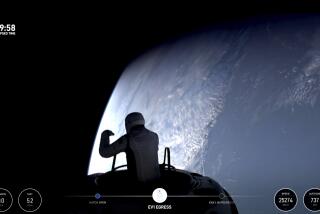Soviets Launch Profit-Driven Space Mission
- Share via
MOSCOW — Two cosmonauts took President Mikhail S. Gorbachev’s drive for economic efficiency to new heights Sunday, blasting off on the Soviet Union’s first space mission designed to turn a multimillion-dollar profit.
Flight commander Anatoly Solovyov, 42, and engineer Alexander Balandin, 36, are to link up with the Mir orbital platform on Tuesday. They will relieve Alexander Viktorenko and Alexander Serebrov, who were launched Sept. 5.
Under Gorbachev, pressures have increased on the country’s once sacrosanct space program to prove its usefulness to the shortage-plagued economy.
This six-month mission has been noisily billed by state-run media as a moneymaker. The spacemen are to put to use the new Kristall module, described by the government daily Izvestia as the first mini-factory for the manufacture of technological and biotechnological materials in zero-gravity conditions.
Through use of Kristall, which is to be shot into orbit March 30 for linkup with Mir, profit of up to $41 million is forecast, the official Tass news agency said.
“For the first time in Soviet cosmonautics, incomes from the flight are expected to exceed by far spending on the spaceship’s launch,” it proclaimed.
The cosmonauts will melt crystals and exploit conditions of weightlessness to manufacture super-pure semi-conductor materials for science and technology, Tass said. “Factories that placed their orders with the cosmonauts are waiting impatiently to put them to use,” it added.
Other moneymaking ventures for the cosmonauts are bio-engineering experiments and photographing the Earth’s surface.
Part of the bio-engineering program was developed with the help of U.S. scientists, Tass said, adding that the joint effort showed how superpower cooperation in space is growing.
While there was no way to audit the huge profits claimed for the Soyuz TM-9 mission by Tass, the accent on profitability was in keeping with the new realities that the Soviet space program is experiencing under Gorbachev.
The mission is the first under the shift of Soviet space research to the “profit-and-loss” accounting system imposed by the Kremlin on factories and farms, Tass said.
Space missions used to be paid for from a central fund, but the Soyuz TM-9 mission is financed by state-run enterprises and organizations that seek some benefit from it, for example by testing technology or conducting experiments, Tass said.
More to Read
Sign up for Essential California
The most important California stories and recommendations in your inbox every morning.
You may occasionally receive promotional content from the Los Angeles Times.













